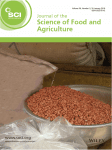A dairy allergy and lactose intolerance are often perceived as the same condition. But, they are very different, with the former being an allergic reaction to a milk protein and the latter being a condition where an individual has a reduced amount of the digestive enzyme, lactase. The discovery of improved detection methods will better help to discriminate between an intolerance and an allergy.
The problematic allergen in cows’ milk is the whey protein, bovine β-lactoglobulin, with 82% of all patients with a cows’ milk allergy being sensitive to this protein. Although strict avoidance of cows’ milk to these individuals seems to be the only solution, this is more difficult in practice due to non-standardized labeling protocols and contamination at the processing and transporting stages. In order to aid in minimizing allergen presence, an efficient and sensitive detection method must be achieved.
Working with the highly specific nature of a specific monoclonal antibody to the bovine β-lactoglobulin protein, He et al. have discovered a successful and reliable method, which uses a sensitive fluorescent sandwich enzyme-linked immunosorbent assay, referred to as sELISA. This method proves reliable in detecting, quantifying and monitoring bovine β-lactoglobulin content following the results from infant formulas.
Using this method in the future detection of food allergens could take the form of a fluorescence biosensor, which could become a key part of a household medical kit.
This Research Article is published in the second issue of the Journal of the Science of Food and Agriculture for 2018, read more like it here.

















